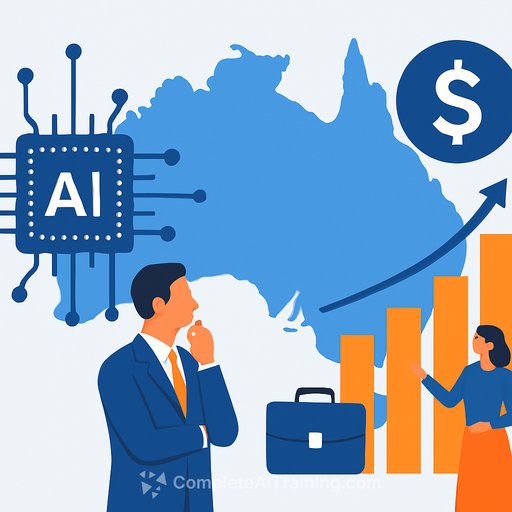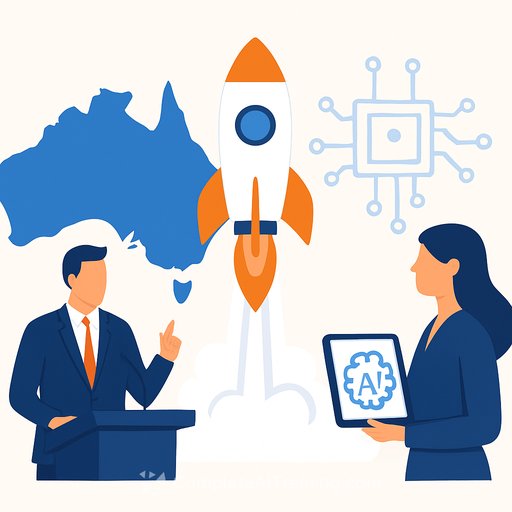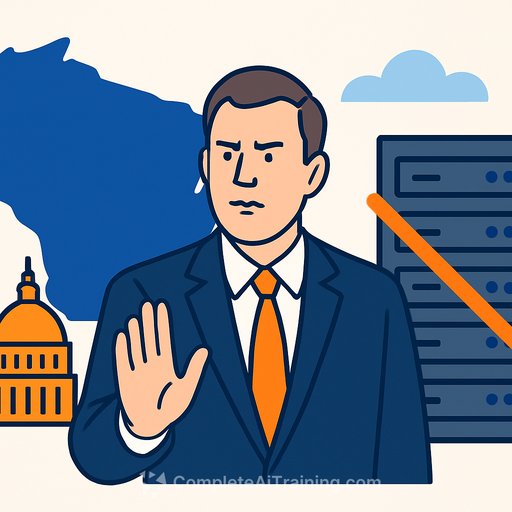Finance Australia's AI Investment Blueprint
Global AI investment is tracking toward $3 trillion by 2026. Some nations are moving fast, setting the pace for growth and standards. Australia has spent just over $300 million in the past five years. That gap matters - for prosperity, security, and cultural identity.
AI lifts GDP in two ways. First, by boosting productivity across the existing economy. Second, by creating a new AI economy: models, applications, data centres, and AI-grade chips that spin up fresh value. Both need a stronger domestic base to stick the landing here at home.
What "sovereign AI" means - and why it matters
Sovereign AI is built, owned, run, and controlled in-country - across both public and private sectors. A credible sovereign base helps reduce dependence on foreign tech and keeps more of the gains onshore. Leading economies are investing over ten times more per capita in the enablers that make this possible. Australia needs to close that gap.
Where the growth comes from
With the right policy and investment, AI could lift Australia's GDP by 6% to 8% over the next decade - an extra $160-$235 billion in 2034. Around three-quarters of that uplift comes from adoption across the existing economy, with small and medium-sized enterprises driving more than half. The rest comes from the new AI economy that didn't exist a few years ago.
One indicator of the pace abroad: the United States is backing a reported $760 billion "Stargate" AI infrastructure push. If Australia delays, we risk importing most of the value we create - and ceding strategic control.
Six priority enablers for government
- Build a national AI talent pipeline: Scale pathways for engineers, data scientists, and AI researchers to develop local models and domain-grade tools.
- Deliver population-scale AI training: Help workers - especially in SMEs - use AI productively and safely. Practical, role-based learning beats theory. Consider curated options like job-aligned AI courses to speed adoption.
- Stand up AI compute at home: Establish purpose-built facilities using affordable renewable energy. Prioritise access for research, startups, and national models.
- Develop specialised models and national datasets: Focus on Australia-specific use cases in national-priority fields (geoscience, health) and heavily regulated sectors (banking). Data governance should be clear from day one.
- Set clear standards and rules: Provide practical guidance so agencies and businesses can comply without guesswork. Align with frameworks like the NIST AI Risk Management Framework to speed trust and adoption.
- Create a network of regional AI factories: Connect talent, research, industry, investors, and government. Make this the centrepiece to translate all other enablers into jobs, exports, and productivity gains.
Funding the move - and crowding in private capital
An additional $5 billion in public funding could attract $27-$49 billion in private capital. Without decisive action, the GDP boost may stall near $85 billion - leaving up to $160 billion on the table. Co-investment structures should be simple, fast, and targeted at areas where Australia can win.
Risks to address early
- Compute and energy: Not enough capacity or affordable energy will bottleneck research and deployment. Plan grid, location, and long-term contracts together.
- Workforce transition: If skills can't keep up, productivity gains won't land. Training and redeployment need to start now, not after tools are deployed.
- Public trust: Be clear about data use, accountability, and recourse when things go wrong. Transparency beats spin.
- Regulatory fit: Strike rules that protect people while allowing experimentation in controlled settings. Sandbox more. Publish templates and checklists.
- Security and misuse: Treat model, data, and supply-chain security as critical infrastructure concerns. Test, red-team, and audit continuously.
12-month action plan for government
- Talent and training: Fund national scholarships, mid-career transitions, and sector academies. Stand up SME vouchers for on-the-job AI training.
- Compute access: Launch a national AI compute facility with tiered access for researchers, startups, and agencies. Lock in renewable energy supply agreements.
- National datasets: Publish high-value, well-documented datasets (health, geoscience, environment) with clear licensing and privacy safeguards.
- Standards and assurance: Issue a government-wide AI assurance kit: model cards, data documentation, risk registers, and procurement clauses aligned to global best practice.
- Procurement reform: Create pre-approved panels for AI services and models. Reward open standards, portability, and local capability development.
- Regional AI factories: Seed 3-5 sites that co-locate compute, labs, venture support, and industry partners. Tie funding to job creation and export targets.
- Co-investment vehicles: Launch a public-private fund for AI infrastructure and strategic models, with milestone-based releases and transparent reporting.
How we'll know it's working
- Growth in domestic AI talent and retention rates
- SME adoption rates and productivity gains by sector
- Utilisation of national compute and time-to-access
- Number of Australia-specific models deployed in priority domains
- Private capital leveraged per public dollar
- Incidents reported, resolved, and lessons published
- Exports from AI products and services
The bottom line
This is a policy and investment window. Build a stronger sovereign base, and Australia can keep more of the value it creates, grow high-wage jobs, and protect national interests. Delay, and we pay more later - in dollars and in choice.
The path is clear: fund the enablers, clear the rules, train the workforce, and connect the parts so value compounds. Start now, measure what matters, and keep shipping progress in quarters - not years.
Your membership also unlocks:





